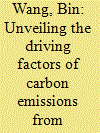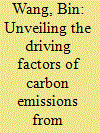|
|
|
Sort Order |
|
|
|
Items / Page
|
|
|
|
|
|
|
| Srl | Item |
| 1 |
ID:
181466


|
|
|
|
|
| Summary/Abstract |
Analyzing the relationship between industrial resource allocation and carbon emissions from the regional level will promote cross-regional environmental coordinated governance. Based on the panel data of 30 provinces from 2007 to 2016, this paper explores the spatial distribution of industrial resource allocation, spatial autocorrelation of carbon emissions, and the relationship from a spatial econometric perspective. The results show that compared with other provinces, Jilin, Zhejiang, and Guangdong have relatively higher industrial resource allocation efficiency. The provinces with higher carbon emissions are spatially adjacent, and the provinces with lower carbon emissions are also spatially adjacent. On a national level, the improvement of industrial resource allocation can reduce carbon emissions. On a regional level, the impact of industrial resource allocation efficiency on carbon emissions is somewhat different. Industrial resource allocation can significantly reduce carbon emissions in the eastern region. However, it is not clear whether the improvement in the industrial resource allocation efficiency can reduce carbon emissions in the central, western, and northeast regions.
|
|
|
|
|
|
|
|
|
|
|
|
|
|
|
|
| 2 |
ID:
181467


|
|
|
|
|
| Summary/Abstract |
Analyzing the relationship between industrial resource allocation and carbon emissions from the regional level will promote cross-regional environmental coordinated governance. Based on the panel data of 30 provinces from 2007 to 2016, this paper explores the spatial distribution of industrial resource allocation, spatial autocorrelation of carbon emissions, and the relationship from a spatial econometric perspective. The results show that compared with other provinces, Jilin, Zhejiang, and Guangdong have relatively higher industrial resource allocation efficiency. The provinces with higher carbon emissions are spatially adjacent, and the provinces with lower carbon emissions are also spatially adjacent. On a national level, the improvement of industrial resource allocation can reduce carbon emissions. On a regional level, the impact of industrial resource allocation efficiency on carbon emissions is somewhat different. Industrial resource allocation can significantly reduce carbon emissions in the eastern region. However, it is not clear whether the improvement in the industrial resource allocation efficiency can reduce carbon emissions in the central, western, and northeast regions.
|
|
|
|
|
|
|
|
|
|
|
|
|
|
|
|
|
|
|
|
|